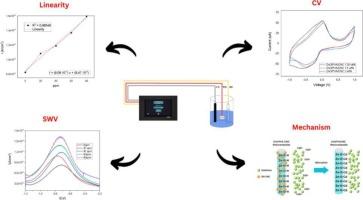Effect of incorporating cellulose nanocrystals into ZnO/PVA nanocomposite for the production of electrochemical sensor to detect cadmium in water
IF 4.2
Q2 CHEMISTRY, MULTIDISCIPLINARY
引用次数: 0
Abstract
Nanocrystalline cellulose is observed to have excellent absorption benefits due to its low cost, biodegradability, and great biocompatibility. The existence of high content of hydroxyl group and large surface area ensures easy modification process. Therefore, changes were implemented to improve the capacity of heavy metal ions for adsorption with the expectation of developing a highly beneficial method of detecting the presence of harmful metal ions capable of harming all living organisms. In this study, cellulose nanocrystals (CNCs) were incorporated into the ZnO/PVA nanocomposites to improve their ability to adsorb metal ions. In the process of analysis, Glassy Carbon Electrode component used ZnO/PVA/CNC as the working material for the electrode. Moreover, X-ray diffraction (XRD), Field Emission Scanning Electron Microscopy (FE-SEM), Photoluminescence, UV–Vis, and I-V spectroscopy were used to analyze the nanocomposites. The results showed that the addition of CNCs enhanced the optical, mechanical, and electrical properties of the ZnO/PVA. Electrochemical measurements using cyclic voltammetry (CV) and square wave voltammetry (SWV) were carried out with varying Cd concentrations. The modified electrode showed enhanced redox activity and a significant increase in peak current response compared to ZnO/PVA without CNC. The sensor demonstrated a linear response toward Cd in the range of 0–80 ppm, with a limit of detection (LOD) of 12.07 ppm. Although the achieved LOD remains above the thresholds required for drinking water safety by regulatory bodies like the WHO, the results underscore the sensor's potential as a foundational platform for further optimization. This study highlights a proof-of-concept application for cadmium detection, particularly relevant in the context of industrial wastewater monitoring.

纤维素纳米晶体加入ZnO/PVA纳米复合材料制备水中镉电化学传感器的效果
纳米晶纤维素由于其低廉的成本、可生物降解性和良好的生物相容性而具有优异的吸收效益。羟基含量高,比表面积大,易于改性。因此,为了开发一种非常有益的方法来检测能够伤害所有生物体的有害金属离子的存在,实施了改进以提高重金属离子的吸附能力。在本研究中,纤维素纳米晶体(cnc)被加入到ZnO/PVA纳米复合材料中,以提高其对金属离子的吸附能力。在分析过程中,玻碳电极组件采用ZnO/PVA/CNC作为电极的工作材料。利用x射线衍射(XRD)、场发射扫描电镜(FE-SEM)、光致发光、UV-Vis和I-V光谱对纳米复合材料进行了分析。结果表明,cnc的加入提高了ZnO/PVA的光学、机械和电学性能。采用循环伏安法(CV)和方波伏安法(SWV)进行了不同镉浓度下的电化学测量。与未加CNC的ZnO/PVA相比,修饰电极的氧化还原活性增强,峰值电流响应显著增加。该传感器在0-80 ppm范围内对Cd具有线性响应,检测限(LOD)为12.07 ppm。虽然达到的LOD仍高于WHO等监管机构要求的饮用水安全阈值,但结果强调了传感器作为进一步优化基础平台的潜力。这项研究强调了镉检测的概念验证应用,特别是在工业废水监测的背景下。
本文章由计算机程序翻译,如有差异,请以英文原文为准。
求助全文
约1分钟内获得全文
求助全文

 求助内容:
求助内容: 应助结果提醒方式:
应助结果提醒方式:


